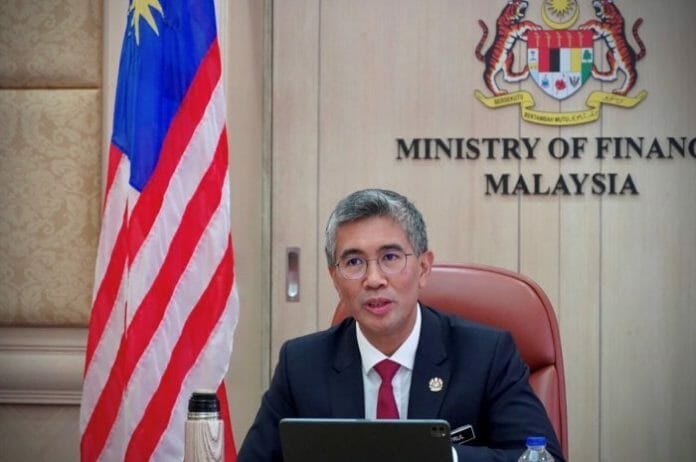Finance Minister echoed Bank Negara’s commentary on Malaysia’s first-quarter economic growth, Tengku Zafrul remarked that the economic growth of 5% was supported by increases in both domestic and external demand, as well as labour market recovery.
He hailed the attribution to the Government’s consistent policy support, particularly initiatives under an expansionary Budget 2022 which have been in full swing since the start of the year, as well as the spillover effect from Budget 2021 and previous stimulus and assistance packages.
Throughout Q1 2022, monthly GDP grew consistently at a rate of 4.3% in January, 5.2% in February, and 5.4% in March. Among the various economic indicators that have shown signs of improvement are:
- Continued labour market recovery, with the unemployment rate at 4.1%, 0.2 percentage points lower compared to the previous quarter, is attributed to the implementation of wage subsidy programmes worth more than RM20 billion and successful job creation initiatives such as JanaKerja and JaminKerja. The unemployment rate is expected to fall further in the coming months as Government assistance continues, and business prospects improve.
- Increased business optimism, in line with strong private consumption. The MIER’S Consumer Sentiment Index rose to 108.9 points in Q1 2022 (Q4 2021: 97.2 points), while the DOSM’s Business Tendency Statistics showed 7.6% confidence indicator (Q4 2021: -0.3%). Overall this was reflected in strong manufacturing sales, which increased by 13.9% to RM144.6 billion in March 2022, as well as wholesale and retail trade sales, which increased 9.8% to RM123.8 billion.
- Robust external trade and foreign direct investments (FDI). Total trade rose 23.6% to RM624.9 billion, while net FDI increased to RM24.4 billion (Q4 2021: RM18.4 billion). Manufacturing, financial and insurance/takaful activities, and wholesale and retail trade attracted the most FDI, primarily from Switzerland, the US, Hong Kong and Japan.
For Malaysia’s financial and capital markets,
- Availability of financing continues to improve, as evidenced by an increase in household loan growth. Outstanding household loans increased by 4.8% (Q4 2021: 4.2%), which is in line with the 12.7% increase in loan disbursements (Q4 2021: 9.5%), outpacing the 3.3% increase in loan repayments (Q4 2021: -4.6%).
- The FBM KLCI rose by 1.3% within Q1 2022, with net purchases from local retail investors totalling RM501 million, and consistent net inflows from foreign investors totalling RM6.5 billion. Bursa Malaysia led ASEAN exchanges in listing proceeds from five initial public offerings worth USD362 million (RM1.6 billion).
MOVING FORWARD
The Malaysian economy is expected to maintain its recovery momentum in 2022. The transition to the endemic phase, as well as the reopening of international borders, will increase tourist arrivals and improve trade and business activities, resulting in a strong recovery in the services sector. Furthermore, the RM10,000 special withdrawal from the Employees’ Provident Fund (EPF) and Bantuan Keluarga Malaysia (BKM) payments are expected to boost private consumption and help the economy recover further.
The expansionary 2022 Budget and the resumption of projects with high multiplier effects will help to sustain growth, which will be supported by an implementation of development programmes under the 12th Malaysian Plan. Together with strong external demand from major trading partners, the economy is on track to meet the 5.3% to 6.3% GDP growth forecast in 2022.
Nonetheless, the Government is cautious of potential downside risks to growth posed by recent global events. Geopolitical tensions, for example, have caused economic pressures on multiple fronts, most notably an increase in global inflation as commodity prices continue to rise. According to the International Monetary Fund (IMF), inflation will rise by 5.7% in advanced economies and 8.7% in emerging markets and developing economies. Malaysia’s inflation is expected to range between 2.2% and 3.2% (2021: 2.5%) this year, in line with the IMF’s forecast of 3.0%, the lowest amongst ASEAN countries.
If global developments continue to affect investment and global trade, supply chains will be impacted further, potentially disrupting Malaysia’s economic recovery momentum, given that we are an open economy with total trade accounting for approximately 120% of GDP. Furthermore, the sharp rise in inflationary pressures, particularly in the US, has prompted several central banks to raise policy rates at a faster pace, potentially leading to tighter global financial conditions. Commodity and food price increases, as well as labour shortages, may limit Malaysia’s growth potential.
Moving forward, the Government and relevant agencies will continue to monitor various economic risks and ensure that policy decisions effectively manage any external shocks that may affect the overall well-being of people and businesses. The Government’s medium-term priority is to implement structural reforms that will boost the country’s economic potential, resilience, and prospects, as well as make Malaysia a more attractive investment destination. Overall, this will promote more sustainable and inclusive economic growth for all.









